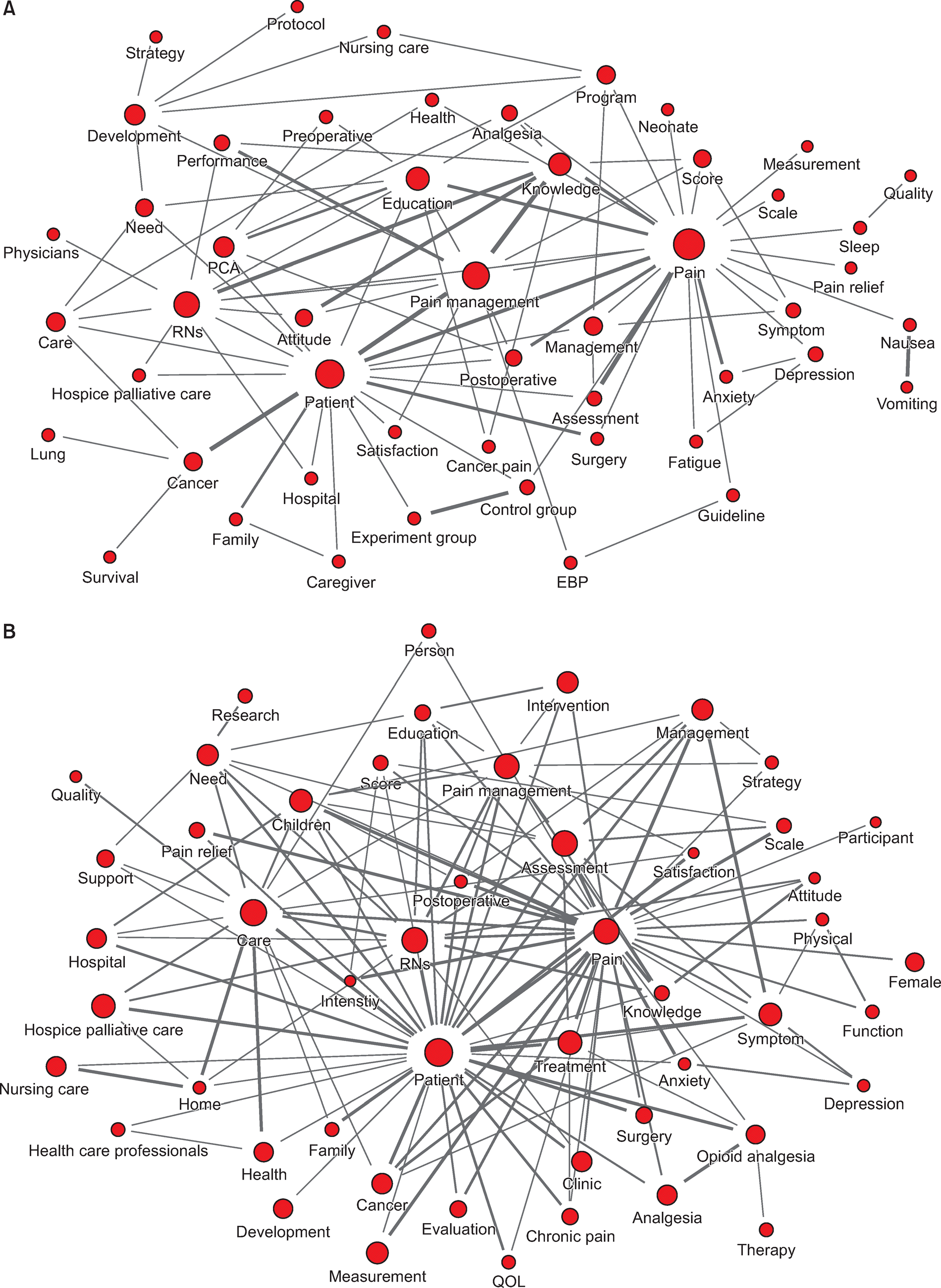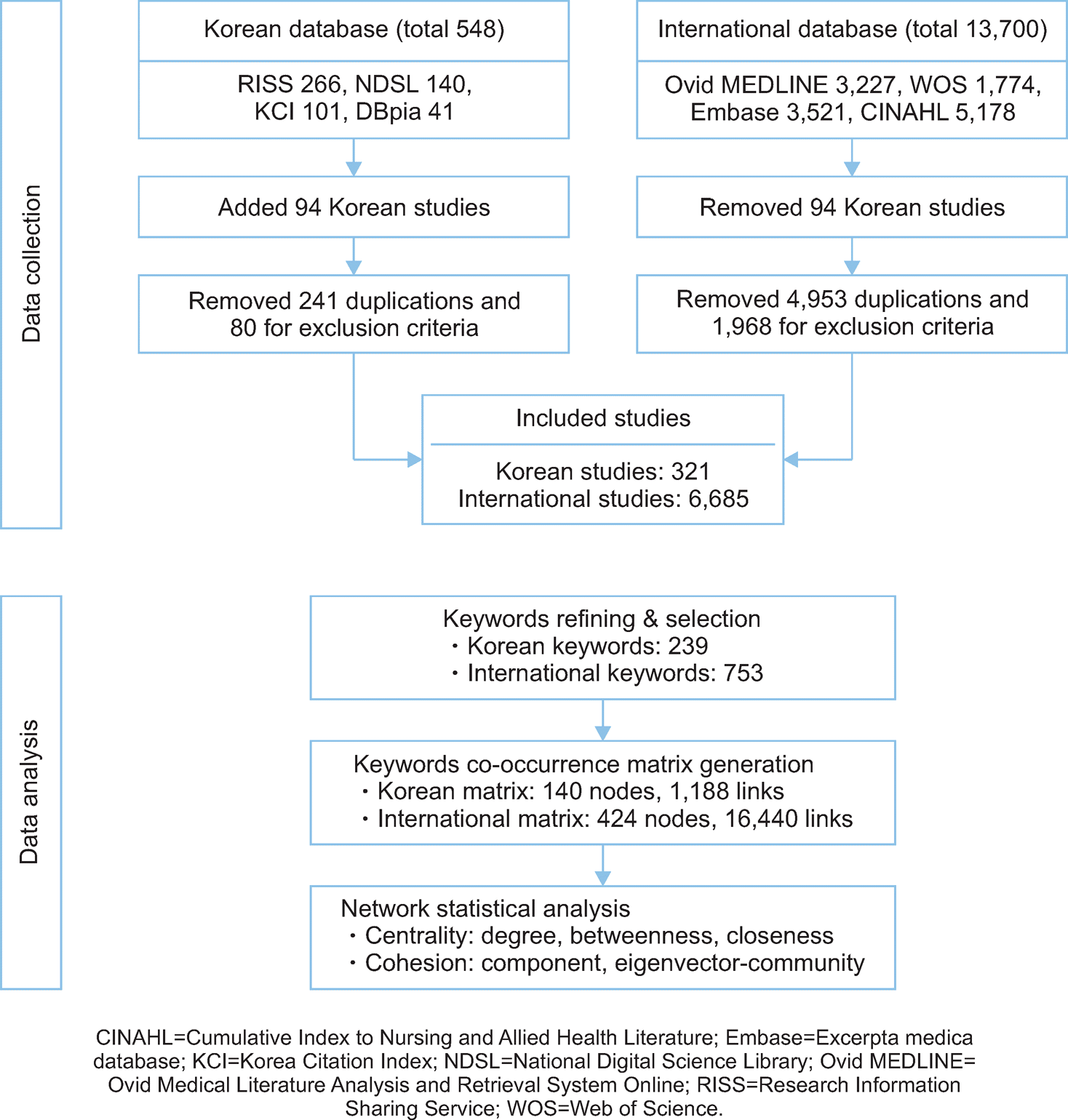Abstract
Purpose
This study aimed to explore and compare the knowledge structure of pain management nursing research, between Korea and other countries, applying a text network analysis.
Methods
321 Korean and 6,685 international study abstracts of pain management, published from 2004 to 2017, were collected. Keywords and meaningful morphemes from the abstracts were analyzed and refined, and their co-occurrence matrix was generated. Two networks of 140 and 424 keywords, respectively, of domestic and international studies were analyzed using NetMiner 4.3 software for degree centrality, closeness centrality, betweenness centrality, and eigenvector community analysis.
Results
In both Korean and international studies, the most important, core-keywords were “pain,” “patient,” “pain management,” “registered nurses,” “care,” “cancer,” “need,” “analgesia,” “assessment,” and “surgery.” While some keywords like “education,” “knowledge,” and “patient-controlled analgesia” found to be important in Korean studies; “treatment,” “hospice palliative care,” and “children” were critical keywords in international studies. Three common sub-topic groups found in Korean and international studies were “pain and accompanying symptoms,” “target groups of pain management,” and “RNs’ performance of pain management.” It is only in recent years (2016~17), that keywords such as “performance,” “attitude,” “depression,” and “sleep” have become more important in Korean studies than, while keywords such as “assessment,” “intervention,” “analgesia,” and “chronic pain” have become important in international studies.
Conclusion
It is suggested that Korean pain-management researchers should expand their concerns to children and adolescents, the elderly, patients with chronic pain, patients in diverse healthcare settings, and patients’ use of opioid analgesia. Moreover, researchers need to approach pain-management with a quality of life perspective rather than a mere focus on individual symptoms.
References
1. Brennan F, Carr DB, Cousins M. Pain management: A fundamental human right. Anesthesia & Analgesia. 2007; 105(1):205–221.

2. Tompkins DA, Hobelmann JG, Compton P. Providing chronic pain management in the “fifth vital sign” era: Historical and treatment perspectives on a modern-day medical dilemma. Drug and Alcohol Dependence. 2017; 173(Suppl 1):S11–S21. https://doi.org/10.1016/j.drugalcdep.2016.12.002.

3. Joint Commission International (JCI). Joint Commission International accreditation standards for hospitals [Internet]. Oakbrook Terrace (IL): JCI;c2017. [cited 2018 Nov 8]. Available from:. https://www.jointcommissioninternational.org/assets/3/7/JCI_Hosp_Standards_6th_STANDARDS_ONLY_14Jan2018.pdf.
4. Korea Institute for Healthcare Accreditation (KOIHA). 3rd cycle of acute care hospital accreditation standards [Internet]. Seoul: KOIHA;c2018. [cited 2018 Nov 2]. Available from:. https://www.koiha.or.kr/member/kr/board/establish/establish_Board-View.do.
5. Gaskin DJ, Richard P. The economic costs of pain in the United States. The Journal of Pain. 2012; 13(8):715–724. https://doi.org/10.1016/j.jpain.2012.03.009.

6. Siddall PJ, Cousins MJ. Persistent pain as a disease entity: Implications for clinical management. Anesthesia & Analgesia. 2004; 99(2):510–520. https://doi.org/10.1213/01.ANE.0000133383.17666.3A.

7. Dopson L. Role of pain management programmes in chronic pain. Nursing Standard. 2010; 25(13):35–40. https://doi.org/10.7748/ns2010.12.25.13.35.c8120.

8. Scher C, Meador L, Van Cleave JH, Reid MC. Moving beyond pain as the fifth vital sign and patient satisfaction scores to improve pain care in the 21st century. Pain Management Nursing. 2018; 19(2):125–129. https://doi.org/10.1016/j.pmn.2017.10.010.

9. Kim HL, Song CE, So HS. Performance of evidence-based pain assessment and management guidelines among medical-surgical nurses. Korean Journal of Adult Nursing. 2016; 28(5):546–558. https://doi.org/10.7475/kjan.2016.28.5.546.

10. Kim YA, Choi SH. Analysis of nursing diagnoses applied to emergency room patients - using the NANDA nursing diagnosis classification -. Journal of Korean Academy of Fundamentals of Nursing. 2015; 22(1):16–24. https://doi.org/10.7739/jkafn.2015.22.1.16.

11. Park JS, Park CJ. An analysis of nursing research on pain reported in Korea from 1970 to1994. The Journal of Nurses Academic Society. 1995; 25(1):30–44. https://doi.org/10.4040/jnas.1995.25.1.30.
12. Yoon HB. Compare study of nursing research in Korea and other country on pain in children. Korean Journal of Child Health Nursing. 2002; 8(2):229–243.
13. Lee SK, Jeong S, Kim HG, Yom YH. A social network analysis of research topics in Korean nursing science. Journal of Korean Academy of Nursing. 2011; 41(5):623–632. https://doi.org/10.4040/jkan.2011.41.5.623.

14. Lee SS. A content analysis of journal articles using the language network analysis methods. Journal of the Korean Society for information Management. 2014; 31(4):49–68. https://doi.org/10.3743/KOSIM.2014.31.4.049.

15. Paranyushkin D. Identifying the pathways for meaning circulation using text network analysis [Internet]. Berlin: Nodus Labs;c2011. [cited 2017 Nov 8]. Available from. https://pdfs.seman-ticscholar.org/97ba/9f29c55ccbdd963e01f98cf17e73998f0f7d.pdf?_ga=2.135032945.1930019695.1562215265-1937325672.1554959705.
16. Kwon SY, Bae KR. A study on the knowledge structure of cancer survivors based on social network analysis. Journal of Korean Academy of Nursing. 2016; 46(1):50–58. https://doi.org/10.4040/jkan.2016.46.1.50.

17. Kim Y, Jang SN. Mapping the knowledge structure of frailty in journal articles by text network analysis. PLoS ONE. 2018; 13(4):e0196104. https://doi.org/10.1371/journal.pone.0196104.

18. Park EJ, Kim Y, Park CS. A comparison of hospice care research topics between Korea and other countries using text network analysis. Journal of Korean Academy of Nursing. 2017; 47(5):600–612. https://doi.org/10.4040/jkan.2017.47.5.600.

19. Lee SS. Network analysis methods applications and limitations. Seoul: CheongRam;2018. p. 105–120.
20. Wasserman S, Faust K. Social network analysis: Methods and applications. New York: Cambridge University Press;1994. p. 167–190.
21. Newman MEJ. Modularity and community structure in networks. Proceedings of the National Academy of Sciences of the United States of America. 2006; 103(23):8577–8582. https://doi.org/10.1073/pnas.0601602103.

22. Newman MEJ. Finding community structure in networks using the eigenvectors of matrices. Physical Review. E, Statistical, Nonlinear, and Soft Matter Physics. 2006; 74(3 Pt 2):036104.

23. Jung-Choi K, Park JY, Kim NS, Park HY. Status of chronic pain prevalence in the Korean adults. Public Health Weekly Report. 2015; 8(31):728–734.
24. World Health Organization (WHO). Scoping document for WHO guidelines for the pharmacological treatment of persisting pain in adults with medical illnesses [Internet]. Geneva: WHO;c2012. [cited 2018 Nov 3]. Available from:. https://www.who.int/medicines/areas/quality_safety/Scoping_WHO_GLs_Per-sistPainAdults_webversion.pdf?ua=1.
25. World Health Organization (WHO). WHO’s cancer pain ladder for adults [Internet]. Geneva: WHO;c2011 [cited 2018 Nov 10]. Available from:. http://www.who.int/cancer/palliative/painladder/en/.
Figure 2.
Sociogram as the knowledge structure of pain management nursing research. (A) Text-network of Korean studies. (B) Text-network of international studies.

Table 1.
Core-topic Keywords of the Pain Management Nursing Research
Table 2.
The Subtopic Groups of Pain Management Nursing Research
| Korean research |
| †1. Pain and accompanying symptoms |
| pain, anxiety, intensity, pain relief, scale, depression, fatigue, neonate, measurement, dysmenorrhea, health, sleep, quality, children, intervention, surgery, nausea, vomiting, guideline, EBP |
| 2. Target groups of pain management |
| patient, cancer, family, care, arthritis, caregiver, PCA, postoperative, QOL, dementia, education, need, preoperative, intravenous, breast, lung, survival |
| 3. RNs’ performance of pain management |
| pain management, knowledge, performance, RNs, barrier, satisfaction, attitude, development, strategy, protocol, hospital, physicians, hospice palliative care, cancer pain, analgesia |
| 4. Symptom management program |
| symptom, management, program, nursing care, assessment, score |
| International research |
| 1. Pain and accompanying symptoms |
| †1) pain, relationship, self-report, abdominal, chest, perineal, complex, ability, stress, discomfort, non-verbal, question, life, burn, self-efficacy, subjective, syndrome, vital signs, dimension, joint, dysmenorrhea |
| 2) symptom, distress, depression, cluster, scale, QOL, fatigue, measurement, score, intensity, anxiety, frequency, improvement, occurrence, gastrointestinal, sleep, respiratory, screen, NRS, VAS, comfort |
| 3) physical, function, psychologic, emotion, social, disability, well-being, spiritual, physiology, behavior, cognition, impairment, bowel |
| 4) validity, reliability, version, instrument, questionnaire, China |
| 5) nausea, vomiting |
| 6) pain score, reduction |
| 2. Target groups of pain management |
| †1) patient, hospitalize, carer, orthopaedic, survival, cardiac, ventilation, heart failure, quality of care, metastasis, fibromyalgia, follow-up, agreement, rehabilitation, teaching, convenience sample, colonoscopy, advocacy, kidney, brain, audit |
| 2) female, male, breast, gender, ethnic, race, participant, cesarian section, interview, semistructured, telephone |
| 3) chronic pain, back pain, non-cancer pain, suffer, wound, healing, individual, lung, disease, head and neck cancer |
| 4) hip, fracture, knee, arthritis |
| 5) leg, ulcer, venous |
| 6) substance, abuse, history |
| 7) neuropathic pain, peripheral, nerve |
| 3. RNs’ performance of pain management |
| †1) pain management, strategy, intervention, education, guideline, nursing care, quality, program, clinic, plan, implementation, evaluation, EBP, documentation, development, research, multidisciplinary approach, management, factor, training |
| 2) RNs, knowledge, assessment, attitude, perception, parent, survey, performance, satisfaction, barrier, researcher, belief, worker, student, consultation, ethics, clinician, gap, translation, confidence |
| 3) family, caregiver, support, hospice palliative care, health, healthcare professionals, physicians, need, information, communication, team, person, HIV/AIDS, policy, healthcare, system, advanced cancer |
| 4. Diverse care settings |
| 1) care, end-of-life, setting, older adult, facility, midwife, holistic, community, cost-effective, acute pain, preference, utilization, pathway, perspective, practitioner, burden, preoperative, decision-making, acute care |
| 2) hospital, admission, unit, discharge, surgery, ward, emergency room, public, ICU, Australia, private, medical, referral, academic, anesthesia, maternity, neonate |
| 3) children, cancer, adolescent, adult, population, illness, vulnerable, SCD, Taiwan |
| 4) home, resident, death, staff, nursing home, dementia |
| 5) science, web-based, United-States, African |
| 6) infant, mother, heel lancing |
| 5. Analgesia and other forms of treatment |
| 1) opioid analgesia, dosage, administration, oral, medication, side effect, drug, fentanyl, long-term care, oxycodone, sucrose |
| 2) treatment, diagnose, modality, protocol, standard, acupuncture, placebo, prevention, CAM, benefit, regimen |
| 3) massage, therapy, hand, technique, relaxation, imagery, music therapy, radiation therapy, chemotherapy, reiki |
| 4) analgesia, PCA, epidural, consumption, sedation, intravenous, cancer pain, PRN analgesia, infusion, acetaminophen |
| 5) pain relief, labor, non-pharmacologic, postoperative, pharmacologic, delirium |




 PDF
PDF ePub
ePub Citation
Citation Print
Print



 XML Download
XML Download